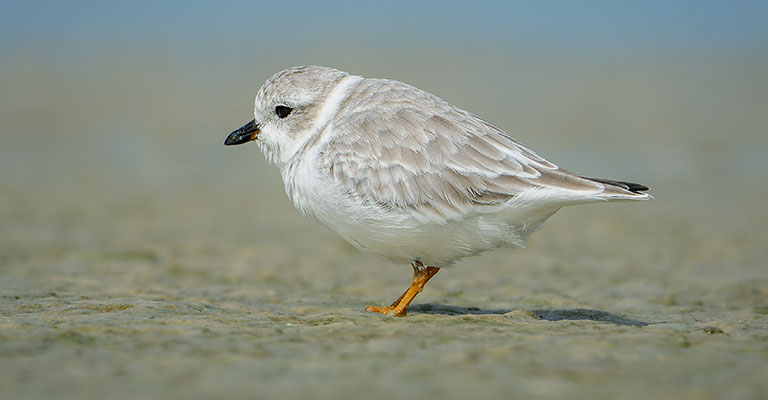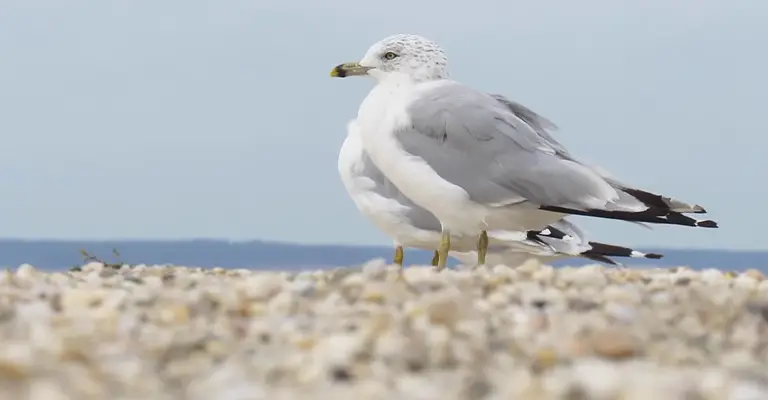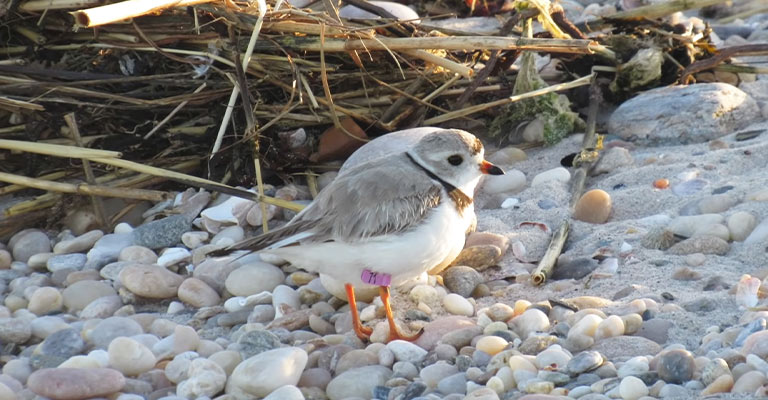The piping plover, a small, sand-colored bird with a distinctive bell-like call, is a North American gem facing a precarious future.
Found primarily along the Atlantic coast, the Great Lakes, and the northern Great Plains, these charming birds are now a rare sight. Their plight is largely due to human activities, which have significantly altered their natural habitats.
Once abundant, piping plovers suffered greatly from the hat-making trade in the late 19th century, leading to protective measures like the Migratory Bird Act of 1918.
However, modern threats such as coastal development and recreational beach use have again put these birds at risk.
With inland populations endangered and coastal ones threatened, the piping plover’s survival depends on our actions.
Understanding the factors contributing to their endangerment is crucial in crafting effective conservation strategies to ensure these delightful birds continue to grace our shores.

Challenges Facing Piping Plover Populations
Piping Plovers face several challenges that threaten their survival. These small shorebirds encounter numerous obstacles in their natural habitats, affecting their ability to thrive.
Loss of Natural Habitat
Development along coastlines has reduced available nesting areas for Piping Plovers. Projects intended for shoreline stabilization contribute further to habitat degradation. As cities expand, the natural sandy stretches these birds depend upon vanish.
Nest Disturbance

Human presence on beaches increases the risk of nest disturbances. People visiting these areas unknowingly disrupt ground nests. Also, off-road vehicles can crush eggs and chicks, significantly impacting breeding success. Pets, when left unchecked, pose another layer of risk.
Impact of Climate Change
Climate change poses a severe threat by altering coastal ecologies. Rising sea levels and severe storms damage nesting sites. These environmental shifts also affect food availability, as changes in climate impact populations of insects and small aquatic invertebrates.
Threats from Predators
Predation is a constant threat to Piping Plovers. Free-roaming cats and other invasive species, such as foxes and raccoons, prey on eggs and chicks. Increased predator populations often relate to human activities, like waste disposal, that attract these animals.
Initiatives for Piping Plover Conservation

Conserving the piping plover involves several key initiatives aimed at protecting critical habitats and reducing threats. These efforts focus on nurturing the environment where the plovers thrive, allowing them to nest safely and increase their population.
Designated Nesting Areas
Establishing designated nesting areas is crucial for piping plover conservation. Agencies have prioritized protecting specific habitats where these birds breed, especially along the Atlantic coast and Great Plains.
Barriers and signage often mark these areas, keeping human activities at bay. Protecting these sites has proven effective, with increased population numbers since these programs began.
Management Strategies for Beaches
Effective beach management strategies play a vital role in plover conservation. Restricting off-road vehicle access and controlling foot traffic in nesting zones are key parts of these strategies.
Such measures reduce disturbances that could harm eggs and chicks. Also, guidelines encourage pet owners to leash their dogs on beaches that serve as nesting grounds, minimizing predation risk.
Ongoing Research and Monitoring
Research and monitoring efforts continue to provide insights into the piping plover’s conservation needs. Studies like the one published in Frontiers in Bird Science evaluate population viability in light of climate change.
By analyzing nesting success and survival rates, researchers can adapt management practices to ensure better outcomes for these birds. Continuous monitoring also alerts conservationists to emerging threats.
Raising Public Awareness and Education
Public awareness and education campaigns are key to fostering community support for plover conservation.
By informing beachgoers about the importance of these birds and their habitats, organizations aim to inspire responsible behavior.
Community involvement often leads to volunteer efforts in monitoring beach activities and participating in conservation initiatives.
Educating the public also helps build understanding and commitment to protecting piping plovers and their habitats.
Looking Ahead: Safeguarding Endangered Piping Plovers

Conservationists keep working tirelessly to safeguard piping plovers to ensure their survival. Efforts focus on habitat protection, public engagement, and continuous research.
Significance of Sustainable Conservation Efforts
Sustainable conservation is key to piping plover survival. These efforts remain essential because they address habitat preservation and reduce human-induced threats.
By implementing predator exclosures and managing beach access, conservationists create safer environments for breeding.
Research, like using video monitoring for nest observation, enhances understanding of these birds’ needs.
Individual Contributions to Piping Plover Protection
Individuals play a critical role in piping plover protection. Awareness is spread by participating in community education programs and volunteering for monitoring efforts.
Adopting responsible beach behavior helps minimize disturbances to nesting sites. Reporting any disturbances or threats quickly aids in prompt conservation responses.
Optimistic Prospects for Piping Plovers
Increasing population numbers reflect the success of current protection strategies. In New England, the population has surpassed recovery goals, indicating promising trends.
Continued management on Virginia’s barrier islands and collaborative efforts highlight a commitment to reversing past declines and securing a stable future for these birds.
Why is it important to protect Piping Plovers?
Protecting piping plovers matters because they play a crucial role in maintaining the health and balance of coastal ecosystems.
Their endangered status highlights the urgency of conservation efforts to ensure their survival and prevent further decline.
Ecological Role
Piping plovers serve a vital function as indicator species, showcasing the overall health of coastal environments.
By managing insect and small crustacean populations, they help maintain the ecological balance of beach areas.
Healthy populations signal pristine beaches, which also benefit coastal communities by providing natural protection against storm surges.
Endangered Status
The piping plover’s endangered status underscores the impact of habitat loss, human disturbances, and predation.
In the 1980s, only 11 nesting pairs were found in the Great Lakes region, but thanks to conservation efforts, this number increased to 76 pairs by 2017.
Despite these gains, fewer than 4,000 breeding pairs exist worldwide, signaling an ongoing need for protection.
Habitat Requirements
These birds rely on specific habitats comprising broad, undisturbed sandy beaches with shells and pebbles. Coastal development and recreational activities have drastically limited these spaces.
Human and pet disturbances frequently lead to nest abandonment and heightened predation risks, emphasizing the need for protected habitats.
Conservation Efforts
Organizations partner with various stakeholders to safeguard piping plovers through habitat restoration and public education.
Efforts include installing barriers to shield nesting sites and enforcing rules to minimize disturbances.
Collaborations like these highlight the critical steps needed to support and restore piping plover populations.
FAQ
Curious about piping plovers and their conservation status? I’ve gathered some critical questions and answers to help you understand why these birds are endangered.
How Many Piping Plovers Are Left in the US?
The US is home to approximately 7,663 breeding piping plovers. On the Atlantic coast, about 4,016 individuals were recorded. Around 3,500 reside in the northern Great Plains and Prairies. In the Great Lakes, their numbers are notably lower, with only 147 recorded.
What Killed Monty the Piping Plover?
Monty, a known piping plover in Chicago, unexpectedly died. Details point to an acute illness, but specific causes weren’t fully documented. Monty represented the challenges these birds face in urbanized habitats.
What is the Lifespan of a Piping Plover?
Piping plovers live for about 3 to 5 years on average. Some individuals might reach 11 years, though many face risks early on.
How Old Was the Oldest Piping Plover?
The record for the oldest known piping plover is 11 years. While not typical, this showcases their potential longevity under favorable conditions.
What is the Biggest Threat to Piping Plovers?
Human activity, including habitat development and recreational disturbances, poses the greatest risk. Predators, often attracted by human refuse, further endanger these birds.
Bottom Line
Understanding the plight of the piping plover is a crucial step toward ensuring their survival. By recognizing the impact of human activities and the importance of these birds to coastal ecosystems, we can work together to protect their habitats.
Conservation efforts have shown promising results, especially in regions where targeted strategies have been implemented.
It’s vital for each of us to contribute, whether through advocacy, volunteering, or simply being mindful of our beach activities.
With continued commitment and collaboration, we can help secure a future where piping plovers thrive, reflecting healthier coastal environments for generations to come.